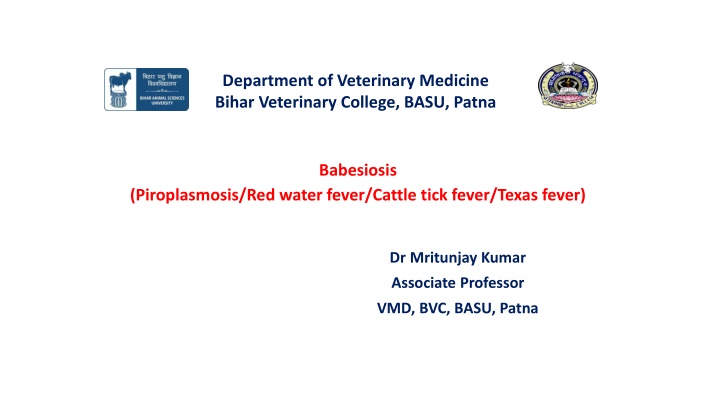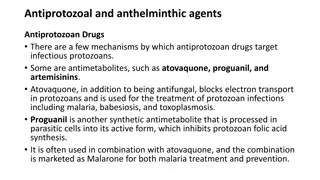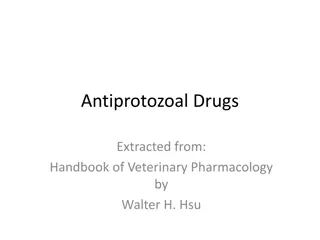
Veterinary Insights: Understanding Babesiosis in Domestic Animals
Dive into the world of babesiosis, a haemoprotozoan disease affecting a wide range of domestic animals, including cattle, sheep, goats, swine, horses, dogs, cats, and even humans. Learn about the etiology, epidemiology, and transmission of this disease to protect your beloved animals from its devastating effects.
Download Presentation

Please find below an Image/Link to download the presentation.
The content on the website is provided AS IS for your information and personal use only. It may not be sold, licensed, or shared on other websites without obtaining consent from the author. If you encounter any issues during the download, it is possible that the publisher has removed the file from their server.
You are allowed to download the files provided on this website for personal or commercial use, subject to the condition that they are used lawfully. All files are the property of their respective owners.
The content on the website is provided AS IS for your information and personal use only. It may not be sold, licensed, or shared on other websites without obtaining consent from the author.
E N D
Presentation Transcript
Department of Veterinary Medicine Bihar Veterinary College, BASU, Patna Babesiosis (Piroplasmosis/Red water fever/Cattle tick fever/Texas fever) Dr Mritunjay Kumar Associate Professor VMD, BVC, BASU, Patna
Babesiosis is a haemoprotozoan disease of a wide range of domestic and wild animals, caused by various species of intra-erythrocytic Babesia spp., transmitted by ticks and characterized by high fever, haemolytic anaemia, jaundice and haemoglobinuria Etiology Etiology Cattle B bigemina and B bovis are widespread in tropical and subtropical areas B. bovis is small piroplasm, with the parasites in paired form at an obtuse angle to each other and measuring ~1 1.5 0.5 1 m. B bigemina is larger piroplasm (3 3.5 1 1.5 m), with paired parasites at an acute angleto each other. Single forms of both parasites are also commonly seen. Babesia divergens (causes pipestem diarrhea) transmitted by Ixodes Ricinus Babesia argentina Babesia major
Sheep and goats: B. motasi, B. ovis, B. foliate Swine: B. trautmanni, B. peroncitoi Horse, Donkey, Mule: B. caballis (T. caballis), B. equi (T. equi, usually four in number, arranged like cross also called maltese appearance) Dogs: Large form (B. canis, B. vogeli,B. rossi) Small form (B. gibsoni, B. vulpes, B. conrade) Cats: B. felis Human: Babesia microti, B. bigemia, B. divergens
Epidemiology Epidemiology worldwide and all the species of domestic animals including man are susceptible Cattle of 6-12 months of age group are highly susceptible Severe form in puppies when compared to adults Causing severe economic loss and common in our country Incidence: In endemic areas, three features are important in determining the risk of clinical disease: 1) Calves have a degree of immunity (related both to colostral-derived antibodies and to age-specific factors) that persists for 6 month 2) Animals that recover from Babesia infections are generally immune for their commercial life (4 yr), and
3) The susceptibility of cattle breeds to ticks and Babesia infections varies eg, Bos indicus cattle tend to be more resistant to ticks and the effects of B bovis and B bigemina infection than Bos taurus derived breeds At high levels of tick transmission, virtually all calves become infected with Babesia by 6 month of age with few or no clinical signs, and subsequently become immune Transmission The main vectors of B. bigemina and B. bovis are 1-host Rhipicephalus (Boophilus) spp ticks, in which transmission occurs trans-ovarially and transtadially Transmission to the host occurs when larvae (in the case of B bovis) or nymphs and adults (in the case of B bigemina) feed Blood inoculation By intra-uterine
Life cycle Sexual cycle (definitive tick host) Tick ingests Babesia spp. gametocytes (IH blood) Gametocytes differentiate into gametes fuse to form zygote Ookinetes kinetes enter into the salivary glands sporozoites (Infective stage) A tick transmits sporozoites while feeding on vertebrate host Transovarial transmission in a tick can also occur Tick Gut Asexual cycle (intermediate host) Sporozoites invade erythrocytes and undergo asexual reproduction Trophozoites Merozoites (spreads throughout the blood) Trophozoite male and female gametocytes (Some of the merozoites produce ) Gametocytes in the red blood cells (intermediate host's)
Pathogenesis Anaemia Lysis of RBCs (multiplication of pyriform bodies Decreased production of cortisol from of babesia by binary fission inside the RBCs cholesterol by the action of progestron due to damage of liver in babesiosis less formation cortisol ( hypocortisolaemia) RBCs becoming more fragile ending in lysis of RBCS Increased prostaglandin level -Increases the vascular permeability; inhibit the most immune response and initiation of the systemic platelet aggregation vascular stasis and subsequent hypoxia of parenchymatous organs resulting in clinical manifestation of disease Severe haemolysis haemoglobinaemia haemoglobinuria Haemoglobin Haem and globin Iron and biliverdin Bilirubin (Jaundice)
Clinical signs IP-1 to 4 weeks B bovis is a much more virulent organism than B bigemina B bigemina: pathogenic effects relate more directly to erythrocyte destruction inflammation, coagulation disturbances, and erythrocytic stasis in capillaries, contribute to the pathogenesis B bovis: hypotensive shock syndrome, combined with generalized non-specific The acute disease generally runs a course of 1 week The first sign is fever (frequently 106 F [41 C]), which persists throughout, and is accompanied later by inappetence, increased respiratory rate, muscle tremors, anemia, jaundice, and weight loss; hemoglobinemia and hemoglobinuria CNS involvement due to adhesion of parasitized erythrocytes in brain capillaries can occur with B bovis infections (Cerebral Babesiosis)
Constipation or diarrhea may or may not be present Late-term pregnant cows may abort, and temporary infertility due to transient fever may be seen in bulls Animals that recover from the acute disease remain infected for a number of years with B. bovis and for a few months in the case of B bigemina No clinical signs are apparent during this carrier state Dog: Lack of energy Lack of appetite Weight loss Fever Swollen abdomen Unusual urine color, unusual stool color, yellow or orange-tinged skin Pale Gums, haemoglobinuria (B.canis) and hepato and splenomegaly Horse and Donkey: Piroplasmosis in horse is a fatal disease with variable clinical sigs of fever, anaemia, haemoglobinuria, colic and jaundice Intra-vascular and extra-vascular haemolysis along with erythrocytic phagocytosis contributes in anaemia, bilirubinuria and haemoglobinuria.
Necropsy findings Lesions (particularly with B bovis) include an enlarged and friable spleen; a swollen liver with an enlarged gallbladder containing thick granular bile; congested, dark-colored kidneys; and generalized anemia and jaundice Most clinical cases of B bigemina have hemoglobinuria, but this is not invariably the case with B bovis Other organs, including the brain and heart, may show congestion or petechiae
Diagnosis 1. Based on clinical signs of high fever, anaemia and haemoglobinuria. 2. By blood examination a) Giemsa or Leishman or Wright staining: Pyriform or pear shaped organisms (merozoites) inside the RBC under oil immersion (100X) b) Wet mount method: Place a drop of blood on slide and mix with drop of normal saline and observe under the low power. c) Haematology: PCV, TEC, Hb are reduced 1. Serological tests: IFAT, ELISA, PCR, CFT etc B. equi (Maltese appearance) B. gibsoni (ring form) B. bigemina (acute angle)
Differential Diagnosis 1) Anaplasmosis: Anaemia, No haemoglobinuria, blood examination spherical body either at the center or periphery of RBC 2) Theileriosis: Anaemia, high fever, enlargement of peripheral lymph nodes, no haemoglobinuria and blood smear examination reveals rod,comma and oval bodies in RBC 3) Leptospirosis: Fever, haemolytic anaemia, no pyriforma bodies in blood smear 4) Post parturient haemoglobinuria: After parturition, anaemia, haemoglobinuria and due tophosphorous deficiency 5) Bacillary haemoglobinuria: Fever, haemoglobinuria, caused by B.haemolyticum 6) Coccidiosis: Seen in young animal having diarrhea, dysentery, anaemia Faecal examinationfor the presence of oocyst
Treatment and Control Earlier trypan blue 1% (100ml for cattle), 5% acriflavine (20 ml for cattle) Presently- Diminazene aceturate and imidocarb dipropionate. Cattle Diminazene aceturate @ 3.5 mg/kg IM single dose, may be repeated after 48 hours Imidocarb dipropionate @ 1.2 mg/kg SC or IM for curative and 3 mg/kg provides protection from babesiosis for 4 weeks It eliminate B bovis and B bigemina from carrier animals Dog and cat Diminazine aceturate is given @ 3.5-5 mg/kg b wt im or s/c and repeated at 14 days intervals (B. canis) Imidocarb dipropionate @ 6.6 mg/kg SC or IM, repeat at 14 days intervals Clindamicin @ 15 mg/kg bid b. wt, Doxycycline @ 10 mg/kg OD b wt, and Metronidazole @ 10-15 mg/kg b wt for 7-10 days (B. gibsoni) Atovaquone @ 13.3 mg/kg b wt thrice daily (15 mg/kg thrice-cat) and Azithromycin@ 10 mg/kg b wt -10days (B. gibsoni)
Horse Diminazene aceturate @ 3.5 mg/kg IM single dose, may be repeated after 48 hours Imidocarb dipropionate @ 5mg/kg SC or IM Cholinergic effect of Imidocarb Salivation, lacrimation, tachypnea, tachycardia, and pain at the injection site, as a result of massive acetylcholine accumulation Anti-dote: Atropine sulphate (0.045 mg/kg s/c or IM) Supportive treatment is advisable, particularly in valuable animals, and may include the use of anti-inflammatory drugs, corticosteroids, and fluid therapy Blood transfusions may be life-saving in very anemic animals Vaccination using live, attenuated strains of the parasites has been used successfully Vector Control: Acaricides like deltamethrin (12.5%), Flumethrin (1%), Amitraz (12.5%), Fipronil etc may be used for tick control Zoonotic Risk A number of cases of human babesiosis have been reported The rodent parasite B microti and the cattle parasite B divergens are the most commonly implicated species in North America and Europe, respectively
Q. Multiple choice questions 1. Cerebral babesiosis in cattle is caused by a) B. bovis b) B. bigemmina c) B. divergens d) None of these 2. Pipe stem diarrhea is caused by a) B. bovis b) B. bigemmina c) B. divergens d) None of these 3. Maltese appearance in RBC in babesiosis in horse indicate a) B. caballis b) B. equi c) Both d) None of these 4. Small form of babesiosis in dog are a) B. gibsoni b) B. vulpes c)B. conrade d) All of these 5. Cholinergic effect is associated with a) Diminazine b) Imidocarb c) Clindamicin d) None


